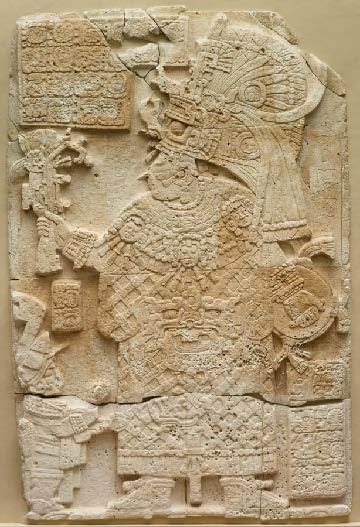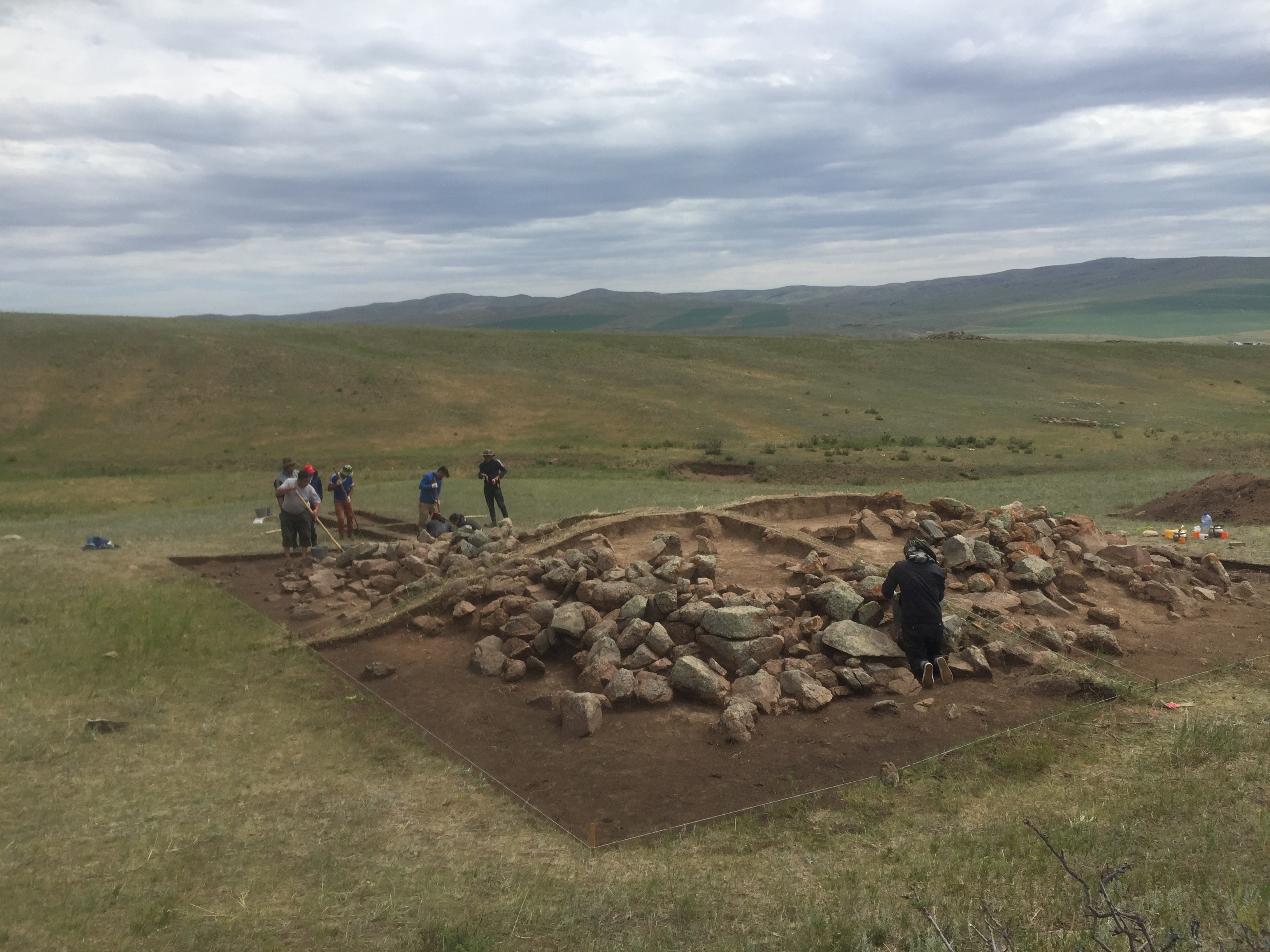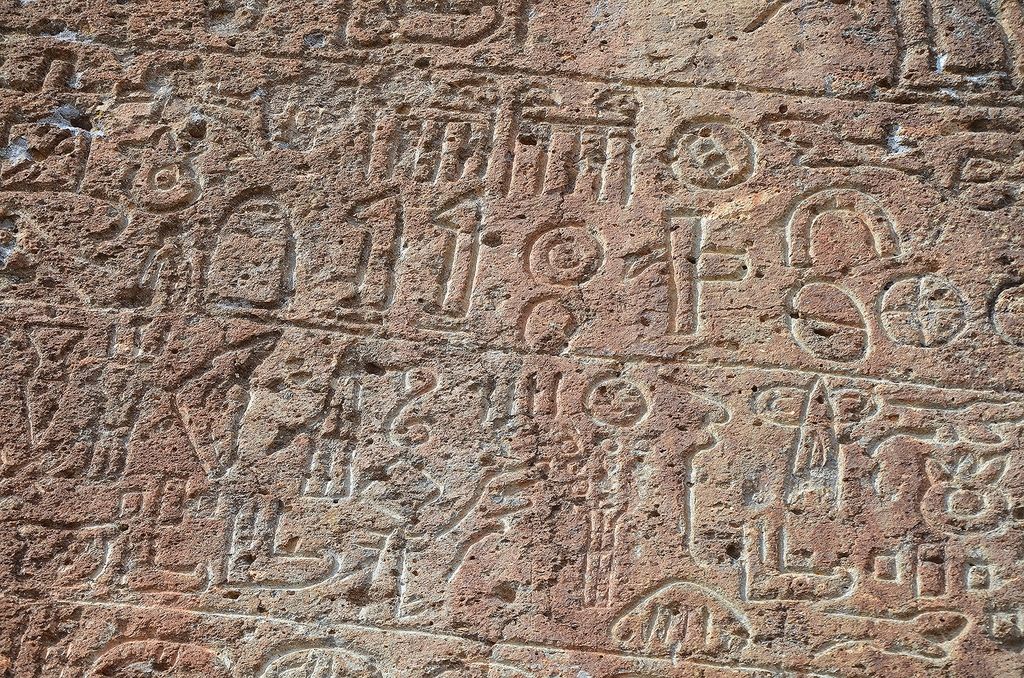Past Events
Interested in Cotsen events? Sign up for our mailing list.Speaker: Dr. Olivia Navarro-Farr, College of Wooster
 Recent investigations in Waka’s primary civic-ceremonial structure discovered a royal tomb including the remains of Queen K’abel. These excavations also revealed the name of an earlier, previously unknown Kaanul queen, Ikoom Sak Wayis, likely pertaining to the interment of a royal female excavated at the site’s palace complex in 2004. This discussion focuses on the wide-ranging evidence that underscores the place of these queens in the collective social memory of ancient Wakeños, their diplomatic capabilities, and their political importance. This examination also serves to initiate conversations about increasing theoretical considerations of how women acted deliberately and meaningfully as agents of ancient statecraft.
Recent investigations in Waka’s primary civic-ceremonial structure discovered a royal tomb including the remains of Queen K’abel. These excavations also revealed the name of an earlier, previously unknown Kaanul queen, Ikoom Sak Wayis, likely pertaining to the interment of a royal female excavated at the site’s palace complex in 2004. This discussion focuses on the wide-ranging evidence that underscores the place of these queens in the collective social memory of ancient Wakeños, their diplomatic capabilities, and their political importance. This examination also serves to initiate conversations about increasing theoretical considerations of how women acted deliberately and meaningfully as agents of ancient statecraft.
Contact Matthew Swanson
Email mswanson@ioa.ucla.edu
Phone
Speaker: Dr. Christine Lee, Assistant Professor, Department of Anthropology, Cal State LA
My research focuses on ethnic identity and how it is expressed in the human skeleton and its burial context. The populations I study were seldom represented in contemporary historical texts. These people included nomadic pastoralists, migrants and merchants, and finally women and children. The first population sample represents the Uighur dynasty in Mongolia. This cemetery dates to the end of the dynasty which was plagued by epidemics and famine before its collapse. Bioarchaeological analysis of Manichaean temple burials show a high mortality rate among infants and periods of high stress among the surviving adults. A second rare archaeological sample dates to Ming-Qing dynasty China. This is the only archaeological site known to have women with bound feet. A complete analysis was done on the occurrence and prevalence of footbinding from the Song –Qing dynasty burials. Next,four archaeological sites from the Western Regions (China and Mongolia) will be discussed regarding trauma patterns along the Silk Road. These are frontier sites from non-Asian Sogdian (Persian) and Pazyryk (Scythian) populations. Finally, current field excavations of several sites which date to the Period of Disunion (Dark Ages), after the collapse of the Han and Xiongnu empires. Little is known about this time other than there was widespread unrest and migration in Mongolia and Northern China. Preliminary findings suggest a change in burial patterns and ethnic identities.

Contact Matthew Swanson
Email mswanson@ioa.ucla.edu
Phone
Speaker: Dr. Thomas Garrison, Ithaca College
In 2016, the National Center for Airborne Laser Mapping (NCALM) acquired over 2100 square km of data over the Maya Biosphere Reserve in Guatemala, representing the largest single LiDAR acquisition for archaeological research. Sponsored by PACUNAM, a consortium of scholars representing different archaeological projects and nationalities have come together to analyze broad trends across the ten individual polygons covered by the data. Notable among the findings are patterns of settlement density and vacancy, an uneven distribution of intensive agricultural systems, and variations in regional connectivity and disconnectivity. A final aspect of the data, seen prominently around the ancient Maya kingdom of El Zotz, is the presence of elaborate systems of site defense. This talk will highlight some basic findings by members of the PACUNAM LiDAR Initiative (PLI) before focusing on what these data tell us about Maya warfare, defense, and politics. Particular attention will be paid to the discovery of a true Maya fortress, dubbed La Cuernavilla, and the implications this site has for understanding Maya politics in the aftermath of Teotihuacan's entrada into the lowlands in the 4th century A.D.

Contact Matthew Swanson
Email mswanson@ioa.ucla.edu
Phone
Speaker: Tao Shi, PhD Candidate, Cotsen Institute of Archaeology, UCLA
The rise of Erlitou not only declares the end of the Longshan Age, but also open a new era of the Luoyang-centric social network. However, how the political landscape was formed and what the knowledge root of Erlitou was have not been discussed. In this paper, I will discuss the Longshan Network as the process of knowledge preparation for the rise of Erlitou. Moreover, I will introduce my survey in the Qinling Mountain Range, and see the Dan River in the Qinling Mountain Range as an expressway of knowledge transmission for the Erlitou state.
Contact Matthew Swanson
Email mswanson@ioa.ucla.edu
Phone
Speaker: Dr. Marcos Llobera, University of Washington
This talk centers on the on-going Landscape, Encounters and Identity project (http://leiap.weebly.com/) and various initiatives by members of the DigAR lab (Digital Archaeology Research Lab -www.digarlab.uw.edu/) at the University of Washington surrounding this project. Broadly speaking, the LEIA project is a landscape archaeology study that seeks to understand landscape and societal changes that played out from Pre-(Late Bronze Age) to medieval times in the Son Servera landscape (NE Mallorca, Spain). In addition to representing the first intensive and systematic surface survey in the island of Mallorca, the project has set out to meet several theoretical, methodological and public goals. Amongst the methodological goals, the project is developing new digital and computational tools for collecting, describing and analyzing survey and landscape data.
Contact Matthew Swanson
Email mswanson@ioa.ucla.edu
Phone
Speaker: Dr. Yanjun Weng, Assistant Professor, Jingdezhen University
Dr. Weng will speak about his current archaeological excavation project at the Luomaqiao Kiln site in Jingdezhen, a city with more than 1,000 years of continuous ceramic industry history. This lecture will explore the changing configuration of porcelain production along the long timeline as well as the corresponding distribution of products to royal needs, government divisions, and civilian markets of both domestic China and overseas.
Yanjun Weng obtained his PhD in archaeology in 2017 from Peking University and has been active on field works of Chinese ceramic archaeology since 2010. Before that, he received master's and undergraduate's degrees in economics and international trade.
Contact Matthew Swanson
Email mswanson@ioa.ucla.edu
Phone
Over the last hundred years or so, a number of theories have been proposed to explain the origins of ancient Israel. All these have been informed to some degree by the biblical text and all have considered the role of New Kingdom Egypt and the collapse of empires throughout the Near East circa 1200-1100 BCE. The lecture will present a radical new proposal: that Egypt itself instigated “Israelite” settlement.
Contact
Phone
Speaker: Dafna Langgut
Cores obtained from the Dead Sea and the Sea of Galilee were used to reconstruct past climate conditions in the Levantine region during the Bronze and Iron Ages. The records were studied in high resolution for their lithological and palynological patterns. Their chronological framework is based on radiocarbon dating of short-lived organic material. The detailed paleoclimate reconstruction points to a dramatic dry event in the later phase of the Late Bronze Age, around the middle of the 13th century BCE. This pronounced dry phase lasted about 120 to 150 years, and was followed by much wetter climate conditions during the Iron Age I. The increasing humidity enabled the expanding of agricultural activities in the area (e.g., cereals, olive). The Iron Age II was characterized by a slight decrease in humidity. This new high resolution paleoclimate reconstruction helps to better understand the so-called “Crisis Years” in the eastern Mediterranean, as well as quick recovery in the Iron I, including the emergence of new entities in the highlands regions of the Levant. It also shed light on the economic strategies of the region’s ancient settlers (e.g., agriculture, grazing).
Contact Matthew Swanson
Phone
Speaker: Dr. Li Min, Associate Professor, Department of Anthropology, UCLA
In this lecture Dr. Li Min will discuss the current trends of Chinese archaeology based on his observations of the conference "In Search of Early China through Archaeology: Celebrating the 70th Anniversary of Chinese Archaeology at UCLA" co-sponsored by the Cotsen Institute of Archaeology. This review of current state of research is followed by a re-visit to the highly contentious topic of the Xia (ca. 2100-1600 BCE), the first dynasty in Chinese historiography and the fountainhead of many important political institutions in Bronze Age China. Instead of debating on the historicity of this legendary regime and the stages of evolutionary typology, Dr. Li Min will approach this topic from the perspective of political experimentation and social memory by asking these questions: What made the late third millennium BCE an important watershed in sociopolitical history of China as seen through the archeological lens? What were the contributions of the Longshan and Erlitou legacy of the early second millennium BCE to the emergence of the Shang civilization during the late second millennium BCE? How was the social memory of the pre-Shang legacy transmitted to the Zhou society at the end of the second millennium BCE? How did the Zhou narratives about the Xia civilization correlate to the archaeological landscape of the second millennium BCE? Against the backdrop of societal collapse in lowland Neolithic centers and intensified interactions with Eurasian exchange networks among the highland communities, I argue that the emergence of major Longshan centers in highland basins during the late third millennium BCE and the subsequent rise of the first Bronze Age city at Erlitou in the Luoyang Basin during the early second millennium BCE had critical contribution to the formation of the Xia legacy in Zhou storytelling about the past. Far from a myth invented by the Zhou to justify its conquest of Shang, the pre-Shang legacy served as major source of political knowledge for the Zhou state-building enterprise and the Xia corresponded to a culturally constructed constellation of political concepts, institutions, and social memories of different episodes of state building from the Longshan and Erlitou periods.
Contact Matthew Swanson
Email mswanson@ioa.ucla.edu
Phone
Speaker: Dr. Lorenzo d'Alfonso, New York University
Drawing upon textual and archaeological data, one can reconstruct the formation of a post-Hittite political entity in Cappadocia, the Land of Tuali, during the late 12th century BCE. This entity grew larger and more structured by the late 10th and 9th centuries before being substantially reduced by the late 8th century expansion of the Assyrian empire toward the northwest. Expanding from this central Anatolian case study, this talk will examine the historical processes that characterized the aftermath of the Hittite empire in Anatolia and the northern Levant and connect them to the fragility, collapse, and regeneration of early polities.

Contact Matthew Swanson
Email mswanson@ioa.ucla.edu
Phone
- ‹ previous
- 36 of 50
- next ›


